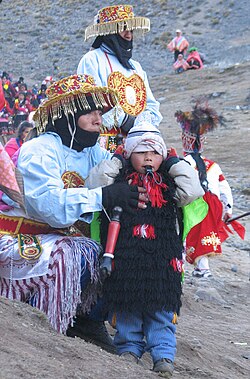
Back السكان الأصليون في البيرو Arabic السكان الاصليين فى البيرو ARZ Pobles indígenes del Perú Catalan Anexo:Pueblos originarios del Perú Spanish بومیهای پرو Persian Piruw suyupi runa llaqtakuna Quechua Peru Kızılderilileri Turkish Người Peru bản địa Vietnamese
 Dancers at Quyllurit'i, an Indigenous festival in Peru | |
| Total population | |
|---|---|
| 5,500,000 [1] 25% of Peru's population[1][2] | |
| Regions with significant populations | |
| Mainly southern regions and Amazon basin (Apurímac, Ayacucho, Huancavelica, Cusco, Puno, Loreto, Junín, Pasco, Huánuco, Ucayali, and Madre de Dios). | |
| Languages | |
| Quechua, Aymara, Peruvian Spanish, and other Indigenous languages | |
| Religion | |
| Roman Catholicism, Native religions | |
| Related ethnic groups | |
| Mestizo, other Quechua, Aymara |

The Indigenous peoples of Peru, or Native Peruvians, comprise a large number of ethnic groups who inhabit territory in present-day Peru. Indigenous cultures developed here for thousands of years before the arrival of the Spanish in 1532.
In 2017, 5,500,000 Peruvians identified themselves as indigenous peoples and formed about 24% of the total population of Peru.[1] At the time of the Spanish arrival, the indigenous peoples of the rain forest of the Amazon basin to the east of the Andes were mostly semi-nomadic tribes; they subsisted on hunting, fishing, gathering and slash and burn agriculture. Those peoples living in the Andes and to the west were dominated by the Inca Empire, who had a complex, hierarchical civilization. It developed many cities, building major temples and monuments with techniques of highly skilled stonemasonry.
Many of the estimated 2000 nations and tribes present in 1500 died out as a consequence of the expansion and consolidation of the Inca Empire and its successor after 1533, the Spanish empire. In the 21st century, the mixed-race mestizos are the largest component of the Peruvian population.
With the arrival of the Spanish, many Natives perished due to Eurasian infectious diseases among the foreigners, to which they had acquired no immunity.
All of the Peruvian Indigenous groups, such as the Urarina,[3] and even those who live isolated in the most remote areas of the Amazon rainforest, such as the Matsés, Matis, and Korubo, have changed their ways of life to some extent under the influence of European-Peruvian culture. They have adopted the use of firearms and other manufactured items, and trade goods, although they remain separated from mainstream Peruvian society. Many Indigenous groups work to uphold traditional cultural practices and identities.
- ^ a b c Cite error: The named reference
ineiwas invoked but never defined (see the help page). - ^ "¿Cómo se autoidentifican los peruanos? Los resultados del censo del INEI". rpp.pe (in Spanish). 11 September 2018. Retrieved 10 December 2020.
- ^ Dean, Bartholomew. (2009) Urarina Society, Cosmology, and History in Peruvian Amazonia, Gainesville, Florida: University Press of Florida ISBN 978-0-8130-3378-5 [1]
© MMXXIII Rich X Search. We shall prevail. All rights reserved. Rich X Search